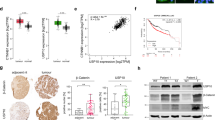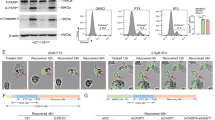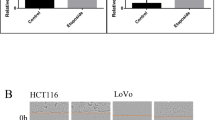Abstracts
Chemotherapy is a widely used treatment for advanced colorectal cancer; however, its efficacy is often limited by chemotherapy resistance, the complex mechanisms of which remain poorly understood. Interestingly, we discovered that the expression levels of USP10 increase in tumor cells in response to chemotherapy, contributing to chemotherapy resistance. Under chemotherapy-induced stress, USP10 stabilizes the Ku70/80 complex in colorectal cancer cells, promoting DNA repair, reducing intracellular ROS levels, and mitigating PANoptosis, which leads to chemotherapy resistance. Additionally, the promoter activity of USP10 is regulated by the non-coding RNA Linc01106. This study also confirmed that the absence of USP10 enhances chemotherapy sensitivity in colorectal cancer cells, providing a potential strategy for overcoming chemotherapy resistance and improving therapeutic outcomes.
This is a preview of subscription content, access via your institution
Access options
Subscribe to this journal
Receive 50 print issues and online access
$259.00 per year
only $5.18 per issue
Buy this article
- Purchase on SpringerLink
- Instant access to full article PDF
Prices may be subject to local taxes which are calculated during checkout









Similar content being viewed by others
Data availability
The data used and/or analyzed in this study can be obtained from the corresponding author on reasonable request.
References
Dekker E, Tanis PJ, Vleugels JLA, Kasi PM, Wallace MB. Colorectal cancer. Lancet. 2019;394:1467–80.
Chen W, Zhu Y, Zhang Z, Sun X. Advances in Salmonella Typhimurium-based drug delivery system for cancer therapy. Advanced Drug Deliv Rev. 2022;185:114295.
Guo Q, Wang H, Duan J, Luo W, Zhao R, Shen Y, et al. An alternatively spliced p62 isoform confers resistance to chemotherapy in breast cancer. Cancer Res. 2022;82:4001–15.
Pothuraju R, Rachagani S, Krishn SR, Chaudhary S, Nimmakayala RK, Siddiqui JA, et al. Molecular implications of MUC5AC-CD44 axis in colorectal cancer progression and chemoresistance. Mol Cancer. 2020;19:37.
Yu T, Guo F, Yu Y, Sun T, Ma D, Han J, et al. Fusobacterium nucleatum promotes chemoresistance to colorectal cancer by modulating autophagy. Cell. 2017;170:548–63.e516.
Jin W. Role of JAK/STAT3 signaling in the regulation of metastasis, the transition of cancer stem cells, and chemoresistance of cancer by epithelial-mesenchymal transition. Cells. 2020;9:217.
Huang R, Zhou PK. DNA damage repair: historical perspectives, mechanistic pathways and clinical translation for targeted cancer therapy. Signal Transduct Target Ther. 2021;6:254.
Srinivas US, Tan BWQ, Vellayappan BA, Jeyasekharan AD. ROS and the DNA damage response in cancer. Redox Biol. 2019;25:101084.
Dasari S, Tchounwou PB. Cisplatin in cancer therapy: molecular mechanisms of action. Eur J Pharmacol. 2014;740:364–78.
Kang L, Tian Y, Xu S, Chen H. Oxaliplatin-induced peripheral neuropathy: clinical features, mechanisms, prevention and treatment. J Neurol. 2021;268:3269–82.
Li H, Wang C, Lan L, Yan L, Li W, Evans I, et al. METTL3 promotes oxaliplatin resistance of gastric cancer CD133+stem cells by promoting PARP1 mRNA stability. Cell Mol Life Sci. 2022;79:135.
Hanker AB, Sudhan DR, Arteaga CL. Overcoming endocrine resistance in breast cancer. Cancer Cell. 2020;37:496–513.
Özeş AR, Miller DF, Özeş ON, Fang F, Liu Y, Matei D, et al. NF-κB-HOTAIR axis links DNA damage response, chemoresistance and cellular senescence in ovarian cancer. Oncogene. 2016;35:5350–61.
Hung T, Wang Y, Lin MF, Koegel AK, Kotake Y, Grant GD, et al. Extensive and coordinated transcription of noncoding RNAs within cell-cycle promoters. Nat Genet. 2011;43:621–9.
Lin JF, Hu PS, Wang YY, Tan YT, Yu K, Liao K, et al. Phosphorylated NFS1 weakens oxaliplatin-based chemosensitivity of colorectal cancer by preventing PANoptosis. Signal Transduct Target Ther. 2022;7:54.
He C, Kawaguchi K, Toi M. DNA damage repair functions and targeted treatment in breast cancer. Breast Cancer. 2020;27:355–62.
Demin AA, Hirota K, Tsuda M, Adamowicz M, Hailstone R, Brazina J, et al. XRCC1 prevents toxic PARP1 trapping during DNA base excision repair. Mol Cell. 2021;81:3018–30.e3015.
Morio T, Kim H. Ku, Artemis, and ataxia-telangiectasia-mutated: signalling networks in DNA damage. Int J Biochem Cell Biol. 2008;40:598–603.
Yu Y, Liu T, Yu G, Wang H, Du Z, Chen Y, et al. PRDM15 interacts with DNA-PK-Ku complex to promote radioresistance in rectal cancer by facilitating DNA damage repair. Cell Death Dis. 2022;13:978.
Lee SH, Kim CH. DNA-dependent protein kinase complex: a multifunctional protein in DNA repair and damage checkpoint. Mol Cells. 2002;13:159–66.
Yoshida K, Fujita M. DNA damage responses that enhance resilience to replication stress. Cellular Mol Life Sci. 2021;78:6763–73.
Dewson G, Eichhorn PJA, Komander D. Deubiquitinases in cancer. Nat Rev Cancer. 2023;23:842–62.
Komander D, Clague MJ, Urbé S. Breaking the chains: structure and function of the deubiquitinases. Nat Rev Mol Cell Biol. 2009;10:550–63.
Komander D, Rape M. The ubiquitin code. Annu Rev Biochem. 2012;81:203–29.
Zella D, Curreli S, Benedetti F, Krishnan S, Cocchi F, Latinovic OS, et al. Mycoplasma promotes malignant transformation in vivo, and its DnaK, a bacterial chaperone protein, has broad oncogenic properties. Proc Natl Acad Sci USA. 2018;115:E12005–e12014.
Zhao X, Ma Y, Li J, Sun X, Sun Y, Qu F, et al. The AEG-1-USP10-PARP1 axis confers radioresistance in esophageal squamous cell carcinoma via facilitating homologous recombination-dependent DNA damage repair. Cancer Lett. 2023;577:216440.
Reissland M, Hartmann O, Tauch S, Bugter JM, Prieto-Garcia C, Schulte C, et al. USP10 drives cancer stemness and enables super-competitor signalling in colorectal cancer. Oncogene. 2024;43:3645–59.
Dou N, Hu Q, Li L, Wu Q, Li Y, Gao Y. USP32 promotes tumorigenesis and chemoresistance in gastric carcinoma via upregulation of SMAD2. Int J Biol Sci. 2020;16:1648–57.
Lin P, Lin C, He R, Chen H, Teng Z, Yao H, et al. TRAF6 regulates the abundance of RIPK1 and inhibits the RIPK1/RIPK3/MLKL necroptosis signaling pathway and affects the progression of colorectal cancer. Cell Death Dis. 2023;14:6.
Causse SZ, Marcion G, Chanteloup G, Uyanik B, Boudesco C, Grigorash BB, et al. HSP110 translocates to the nucleus upon genotoxic chemotherapy and promotes DNA repair in colorectal cancer cells. Oncogene. 2019;38:2767–77.
Kuo LJ, Yang LX. Gamma-H2AX - a novel biomarker for DNA double-strand breaks. In Vivo. 2008;22:305–9.
Kabakov AE, Gabai VL. Cell death and survival assays. Methods Mol Biol. 2018;1709:107–27.
Kayagaki N, Kornfeld OS, Lee BL, Stowe IB, O’Rourke K, Li Q, et al. NINJ1 mediates plasma membrane rupture during lytic cell death. Nature. 2021;591:131–6.
Yuan J, Luo K, Zhang L, Cheville JC, Lou Z. USP10 regulates p53 localization and stability by deubiquitinating p53. Cell. 2010;140:384–96.
Wang X, Xia S, Li H, Wang X, Li C, Chao Y, et al. The deubiquitinase USP10 regulates KLF4 stability and suppresses lung tumorigenesis. Cell Death Differ. 2020;27:1747–64.
Wu F, Du Y, Yang J, Shao B, Mi Z, Yao Y, et al. Peroxidase-like active nanomedicine with dual glutathione depletion property to restore oxaliplatin chemosensitivity and promote programmed cell death. ACS Nano. 2022;16:3647–63.
Zhang Q, Deng T, Zhang H, Zuo D, Zhu Q, Bai M, et al. Adipocyte-derived exosomal MTTP suppresses ferroptosis and promotes chemoresistance in colorectal cancer. Adv Sci. 2022;9:e2203357.
Takahashi M, Higuchi M, Makokha GN, Matsuki H, Yoshita M, Tanaka Y, et al. HTLV-1 Tax oncoprotein stimulates ROS production and apoptosis in T cells by interacting with USP10. Blood. 2013;122:715–25.
Aulas A, Finetti P, Lyons SM, Bertucci F, Birnbaum D, Acquaviva C, et al. Revisiting the concept of stress in the prognosis of solid tumors: a role for stress granules proteins? Cancers. 2020;12:2470.
Zhu H, Yan F, Yuan T, Qian M, Zhou T, Dai X, et al. USP10 promotes proliferation of hepatocellular carcinoma by deubiquitinating and stabilizing YAP/TAZ. Cancer Res. 2020;80:2204–16.
Hu C, Zhang M, Moses N, Hu CL, Polin L, Chen W, et al. The USP10-HDAC6 axis confers cisplatin resistance in non-small cell lung cancer lacking wild-type p53. Cell Death Dis. 2020;11:328.
Kubaichuk K, Kietzmann T. USP10 contributes to colon carcinogenesis via mTOR/S6K mediated HIF-1α but not HIF-2α protein synthesis. Cells. 2023;12:1585.
Fisusi FA, Akala EO. Drug combinations in breast cancer therapy. Pharm Nanotechnol. 2019;7:3–23.
Wei G, Wang Y, Yang G, Wang Y, Ju R. Recent progress in nanomedicine for enhanced cancer chemotherapy. Theranostics. 2021;11:6370–92.
de Armas S, Huertas-Ayala C, Chan RY, Chi YY, Huh WW, Termuhlen A, et al. Survival of pediatric Hodgkin lymphoma patients treated with doxorubicin, bleomycin, vincristine, etoposide, prednisone, and cyclophosphamide (ABVE-PC) versus doxorubicin, bleomycin, vinblastine, and dacarbazine (ABVD) at a single institution. Pediatr Blood Cancer. 2022;69:e29601.
Kumari N, Antil H, Kumari S, Raghavan SC. Deficiency of ligase IV leads to reduced NHEJ, accumulation of DNA damage, and can sensitize cells to cancer therapeutics. Genomics. 2023;115:110731.
Mailloux A, Grenet K, Bruneel A, Bénéteau-Burnat B, Vaubourdolle M, Baudin B. Anticancer drugs induce necrosis of human endothelial cells involving both oncosis and apoptosis. Eur J Cell Biol. 2001;80:442–9.
Nishi R, Wijnhoven PWG, Kimura Y, Matsui M, Konietzny R, Wu Q, et al. The deubiquitylating enzyme UCHL3 regulates Ku80 retention at sites of DNA damage. Sci Rep. 2018;8:17891.
Sharma A, Alswillah T, Kapoor I, Debjani P, Willard B, Summers MK, et al. USP14 is a deubiquitinase for Ku70 and critical determinant of non-homologous end joining repair in autophagy and PTEN-deficient cells. Nucleic Acids Res. 2020;48:736–47.
Chen H, Li Y, Li H, Chen X, Fu H, Mao D, et al. NBS1 lactylation is required for efficient DNA repair and chemotherapy resistance. Nature. 2024;631:663–9.
Wei Z, Zeng K, Hu J, Li X, Huang F, Zhang B, et al. USP10 deubiquitinates Tau, mediating its aggregation. Cell Death Dis. 2022;13:726.
Pan L, Chen Z, Wang L, Chen C, Li D, Wan H, et al. Deubiquitination and stabilization of T-bet by USP10. Biochem Biophys Res Commun. 2014;449:289–94.
Xia X, Hu T, He J, Xu Q, Yu C, Liu X, et al. USP10 deletion inhibits macrophage-derived foam cell formation and cellular-oxidized low density lipoprotein uptake by promoting the degradation of CD36. Aging. 2020;12:22892–905.
Sola-Sevilla N, Puerta E. SIRT2 as a potential new therapeutic target for Alzheimer’s disease. Neural Regen Res. 2024;19:124–31.
Hayes JD, Dinkova-Kostova AT, Tew KD. Oxidative stress in cancer. Cancer Cell. 2020;38:167–97.
Sies H, Jones DP. Reactive oxygen species (ROS) as pleiotropic physiological signalling agents. Nat Rev Mol Cell Biol. 2020;21:363–83.
Chen H, Yoshioka H, Kim GS, Jung JE, Okami N, Sakata H, et al. Oxidative stress in ischemic brain damage: mechanisms of cell death and potential molecular targets for neuroprotection. Antioxid Redox Signal. 2011;14:1505–17.
Chi H, Peng G, Wang R, Yang F, Xie X, Zhang J, et al. Cuprotosis programmed-cell-death-related lncRNA signature predicts prognosis and immune landscape in PAAD patients. Cells. 2022;11:3436.
Wu Z, Lu Z, Li L, Ma M, Long F, Wu R, et al. Identification and validation of ferroptosis-related LncRNA signatures as a novel prognostic model for colon cancer. Front Immunol. 2021;12:783362.
Zhang Y, Luo M, Cui X, O’Connell D, Yang Y. Long noncoding RNA NEAT1 promotes ferroptosis by modulating the miR-362-3p/MIOX axis as a ceRNA. Cell Death Differ. 2022;29:1850–63.
Gao X, Yu L, Zhang J, Xue P. Silencing of long non-coding RNA LINC01106 suppresses the proliferation, migration and invasion of endometrial cancer cells through regulating the miR-449a/MET axis. Onco Targets Ther. 2020;13:9643–55.
Guo K, Gong W, Wang Q, Gu G, Zheng T, Li Y, et al. LINC01106 drives colorectal cancer growth and stemness through a positive feedback loop to regulate the Gli family factors. Cell Death Dis. 2020;11:869.
Hong S, Li Q, Yang Y, Jing D, Zhu F. Silencing of long non-coding RNA LINC01106 represses malignant behaviors of gastric cancer cells by targeting miR-34a-5p/MYCN axis. Mol Biotechnol. 2022;64:144–55.
Liu J, Tian C, Qiao J, Deng K, Ye X, Xiong L. m6A methylation-mediated stabilization of LINC01106 suppresses bladder cancer progression by regulating the miR-3148/DAB1 axis. Biomedicines. 2024;12:114.
Meng L, Xing Z, Guo Z, Liu Z. LINC01106 post-transcriptionally regulates ELK3 and HOXD8 to promote bladder cancer progression. Cell Death Dis. 2020;11:1063.
Funding
This study was supported by the National Natural Science Foundation of China (No. 82273361), the Joint Funds for the Innovation of Science and Technology, Fujian Province (No. 2024Y9208), the National Natural Science Foundation of Fujian Province (No. 2023J06032).
Author information
Authors and Affiliations
Contributions
JXY and GWZ designed this experiment. PHL and CLL conducted experiments. ZHT and SYL analyzed data. XL, RFH, and HXY explained the experimental results. PHL and CLL prepared these figures. GWZ and PHL wrote this manuscript. JXY and ZHT contributed to manuscript editing. All authors participated in reading and discussing the manuscript.
Corresponding authors
Ethics declarations
Competing interests
The authors declare no competing interests.
Ethics approval and consent to participate
This study was approved by the Institutional Review Board (IRB) of the First Affiliated Hospital of Fujian Medical University (permit number: MRCTA, ECFAH of FMU [2022] 515) and conducted in strict accordance with the Declaration of Helsinki. Written informed consent was obtained from each patient before enrollment. All animal experiments were reviewed by the Animal Management and Use Ethics Committee of Fujian Medical University and relevant animal associations (permit number: IACUC FJMU 2023-Y-0975). Every effort was made to minimize animal suffering.
Additional information
Publisher’s note Springer Nature remains neutral with regard to jurisdictional claims in published maps and institutional affiliations.
Supplementary information
Rights and permissions
Springer Nature or its licensor (e.g. a society or other partner) holds exclusive rights to this article under a publishing agreement with the author(s) or other rightsholder(s); author self-archiving of the accepted manuscript version of this article is solely governed by the terms of such publishing agreement and applicable law.
About this article
Cite this article
Lin, P., Lin, C., Teng, Z. et al. USP10-mediated Ku70/80 stabilization inhibits PANoptosis and promotes chemoresistance in colorectal cancer. Oncogene (2025). https://doi.org/10.1038/s41388-025-03570-2
Received:
Revised:
Accepted:
Published:
DOI: https://doi.org/10.1038/s41388-025-03570-2



